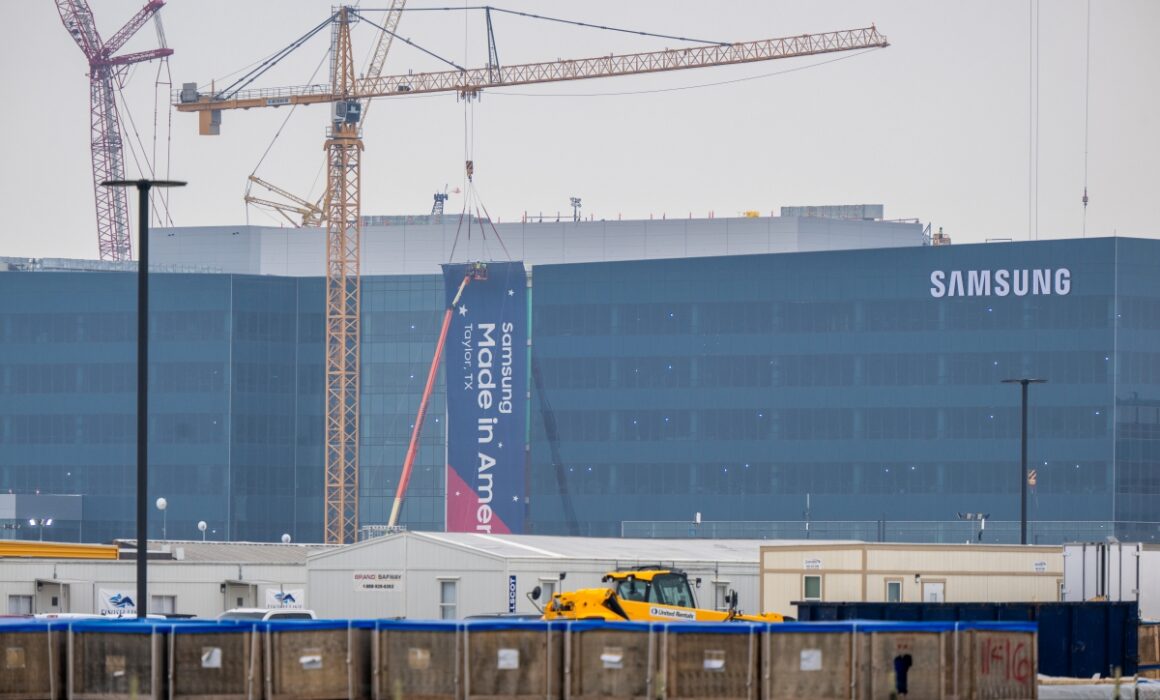An Inside Look at How Industrial Policy Gets Done
October 11, 2024
Three former administration officials discuss the why and how of industrial policy.
The Roosevelt Rundown features our top stories of the week.

A Samsung semiconductor plant in Taylor, Texas. (Photo credit: Brandon Bell/Getty Images)
How Industrial Policy Happens
In 2022, the government passed two massive policy packages—the Inflation Reduction Act and the CHIPS and Science Act—to shore up clean energy and semiconductor manufacturing and strengthen the resilience of domestic industries through public investment. But securing the funding isn’t all it takes: Implementation requires state capacity and coordination. In a new Q&A, Roosevelt’s Todd N. Tucker spoke with three of the architects of this new industrial strategy to understand how and why it all happened—and what comes next.
“Climate change is the big market failure,” said climate expert Kate Gordon, a former senior advisor in the Biden administration and in the office of California Governor Gavin Newsom. Tackling the climate crisis will require “shifting the entire economy from one built on a set of fossil fuels . . . to a whole new type of industry and set of industries,” she told Tucker.
“The government’s intervention is crucial,” agreed Satyam Khanna, who formerly served in the Environmental Protection Agency. “Markets have historically underserved low-income and disadvantaged communities,” and “sought shorter-term returns than green projects have been able to deliver,” he explained. “The result is a green financing gap.” To address what the market wouldn’t, Khanna led the development of a new Greenhouse Gas Reduction Fund, which uses public money to fund clean energy projects.
“When [a] piece of infrastructure or an input is so important to the global economy and to our national security,” the state can’t risk leaving it to markets, said Ronnie Chatterji, who oversaw implementation of the CHIPS and Science Act for the White House. Strengthening critical industries like semiconductors also requires policymakers to have access to the right data and resources. “We need really smart analytical tools at the government’s disposal to understand supply chains and understand where the bottlenecks are,” said Chatterji.
Over the next decade, implementing the IRA and CHIPS Act—and formulating new bold government programs—will remain a top policy priority. These insights from former administration officials help us understand how federal agencies are “plugging gaps in private markets,” writes Tucker, as markets “can’t or won’t coordinate economy-wide transitions in energy systems, invest in needy communities at the necessary scale and speed, or account for national security concerns.”
Read more: “How Industrial Policy Gets Done: Frontline Lessons from Three Federal Officials.”
Roosevelt Network Undergraduate Fellowship Applications Are Open
“I cannot recommend the Roosevelt Network enough. Not only does it have great connections and resources in the policy world, it provides a space to brainstorm and discuss a way forward for novel progressive ideas.”
— Inica Kotasthane, 2023 Forge Fellow, 2024 Roosevelt in Washington Fellow
Are you or is someone in your network an undergraduate student interested in policy, economics, and politics? The Roosevelt Network’s fellowship programs are now accepting applications for the 2025–26 cycle. The Network offers three fellowships:
- The virtual Forge Fellowship introduces first- and second-years to the fundamentals of progressive policy;
- The Roosevelt in Washington Fellowship places second- and third-years in internships at partner organizations and includes a summer in Washington, DC; and
- The Emerging Fellowship helps students in the last one or two years of their degree program conduct an in-depth research project and write a policy brief to be published by Roosevelt.
The Roosevelt Network provides training and mentorship for young professionals—particularly those who have historically been denied political power—to become leaders in the progressive policy ecosystem.
What We’re Talking About
About 7.4 mil Americans benefit from the Supplemental Security Income (SSI) program, but more than 50% of SSI recipients live ⬇️ the poverty line even with the benefit.
In his new blog, Stephen Nuñez shares how we can update the program: https://t.co/EGbmgGgbEz pic.twitter.com/5QaeA7JGAi
— Roosevelt Institute (@rooseveltinst) October 10, 2024
What We’re Reading
Diversity Data Underscores IRS’s Challenge of Enacting Change – Bloomberg Law – by Roosevelt Senior Fellow Beverly Moran
Helene Should Trigger a National Rethink of Home Insurance – The New Republic – by Roosevelt Fellow Kate Aronoff
Inflation Falls to 2.1 Percent, Lowest in 3 Years – Axios
How the DOJ Wants to Break Up Google’s Search Monopoly – The Verge
Fossil Fuel Interests Are Working to Kill Solar in One Ohio County. The Hometown Newspaper Is Helping. – ProPublica